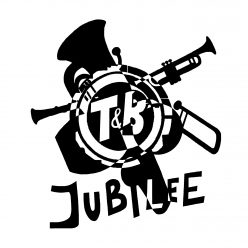English translation
Traduction Français
Zaterdag 16 september 2017
Zonneplein
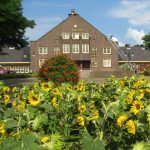 Het Zonneplein is het hart van Tuindorp Oostzaan. De gemeente Amsterdam bouwde tussen de Eerste en de Tweede Wereldoorlog tuindorpen om een tegenwicht te bieden aan de verpauperde volksbuurten in de binnenstad. Tuindorp Oostzaan is gebouwd in de Amsterdamse School-stijl. Kenmerken van die architectuur zijn uitbundige baksteenreliëfs, natuurstenen versieringen in de gevels en ramen met kleine vlakverdeling. In 1960 stond deze wijk na een dijkdoorbraak bijna twee meter onder water.
Het Zonneplein is het hart van Tuindorp Oostzaan. De gemeente Amsterdam bouwde tussen de Eerste en de Tweede Wereldoorlog tuindorpen om een tegenwicht te bieden aan de verpauperde volksbuurten in de binnenstad. Tuindorp Oostzaan is gebouwd in de Amsterdamse School-stijl. Kenmerken van die architectuur zijn uitbundige baksteenreliëfs, natuurstenen versieringen in de gevels en ramen met kleine vlakverdeling. In 1960 stond deze wijk na een dijkdoorbraak bijna twee meter onder water.
De winkels rondom het Zonneplein kampten de afgelopen jaren met leegstand. Betrokken ondernemers proberen weer nieuw leven in de buurt te brengen. Zij organiseren regelmatig de Amsterdam Village Market, waarbij straatmuziek nooit ontbreekt.
Amsterdam Museum
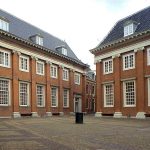 Het Amsterdam Museum ligt tussen de Kalverstraat en de Nieuwezijds Voorburgwal. De geschiedenis van deze plek gaat terug tot de middeleeuwen, toen hier het Sint-Luciënklooster gevestigd was: een vrouwenklooster met een eigen bierbrouwerij en veestapel. De stal stond ongeveer op de plek waar nu het museumcafé is.
Het Amsterdam Museum ligt tussen de Kalverstraat en de Nieuwezijds Voorburgwal. De geschiedenis van deze plek gaat terug tot de middeleeuwen, toen hier het Sint-Luciënklooster gevestigd was: een vrouwenklooster met een eigen bierbrouwerij en veestapel. De stal stond ongeveer op de plek waar nu het museumcafé is.
Van 1578 tot 1960 was hier het Burgerweeshuis. Honderden wezen kregen hier onderdak en een opleiding. Op de jongensbinnenplaats zijn nog de kastjes te zien waarin de wezen hun spullen bewaarden. Op de meisjesbinnenplaats zijn vaak concerten; op 16 september van straatorkesten.
Frederiksplein
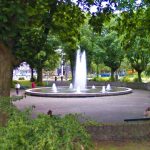 Hier stond in de 19e eeuw het Paleis voor Volksvlijt: een groot glazen tentoonstellingsgebouw, vergelijkbaar met het Crystal Palace in Londen. Het paleis werd in 1929 door brand verwoest. De galerij bleef nog een tijd staan en was onder meer oefenterrein van Circus Elleboog, een Amsterdams jeugdcircus. De galerij werd in 1960 gesloopt toen hier het hoofdkantoor van de Nederlandsche Bank werd gebouwd. Het gebouw werd in 1991 uitgebreid met de ronde toren. De gebouwen kregen toen de bijnamen luciferdoosje en aansteker. Op het plein stond vroeger ook een muziekkoepel. Een stichting organiseert weer concerten in muziekkoepels, ook op plekken waar ze nu niet meer staan. Toeters & Bellen speelde hier al een paar keer.
Hier stond in de 19e eeuw het Paleis voor Volksvlijt: een groot glazen tentoonstellingsgebouw, vergelijkbaar met het Crystal Palace in Londen. Het paleis werd in 1929 door brand verwoest. De galerij bleef nog een tijd staan en was onder meer oefenterrein van Circus Elleboog, een Amsterdams jeugdcircus. De galerij werd in 1960 gesloopt toen hier het hoofdkantoor van de Nederlandsche Bank werd gebouwd. Het gebouw werd in 1991 uitgebreid met de ronde toren. De gebouwen kregen toen de bijnamen luciferdoosje en aansteker. Op het plein stond vroeger ook een muziekkoepel. Een stichting organiseert weer concerten in muziekkoepels, ook op plekken waar ze nu niet meer staan. Toeters & Bellen speelde hier al een paar keer.
Noorderlicht
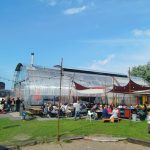 Café Noorderlicht bevindt zich op het NDSM-terrein, een voormalige scheepswerf. Hier werden tussen 1915 en 1984 zeeschepen gebouwd. Na het faillissement werden de leegstaande gebouwen gekraakt. Het werd een van de grootste Amsterdamse broedplaatsen met betaalbare woon- en werkruimten voor kunstenaars, ambachtslieden en ondersteunende bedrijfjes. Op dit terrein is elk jaar in juni het Over het IJ Festival, met veel locatietheater. Café Noorderlicht is duurzaam gebouwd in een hergebruikte halfronde loods en geïsoleerd met strobalen.
Café Noorderlicht bevindt zich op het NDSM-terrein, een voormalige scheepswerf. Hier werden tussen 1915 en 1984 zeeschepen gebouwd. Na het faillissement werden de leegstaande gebouwen gekraakt. Het werd een van de grootste Amsterdamse broedplaatsen met betaalbare woon- en werkruimten voor kunstenaars, ambachtslieden en ondersteunende bedrijfjes. Op dit terrein is elk jaar in juni het Over het IJ Festival, met veel locatietheater. Café Noorderlicht is duurzaam gebouwd in een hergebruikte halfronde loods en geïsoleerd met strobalen.
Tolhuistuin
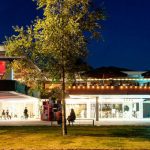 Op deze plek lag de tuin van een tolhuis: hier moest je tol betalen om vanaf Amsterdam over de trekvaart verder te varen naar het noorden. De tuin groeide in de 19e eeuw uit tot een lusthof: een plek waar rijke Amsterdammers genoten van de frisse lucht en waar regelmatig concerten waren. Het huidige gebouw uit de jaren 60 was het bedrijfsrestaurant van het Shell Laboratorium. De zaal wordt geëxploiteerd door Paradiso, de beroemde muziektempel (in een voormalige kerk) bij het Leidseplein. Vanwege de ligging heet deze zaal Paradiso Noord. Hier is het feest van T&B Jubilee.
Op deze plek lag de tuin van een tolhuis: hier moest je tol betalen om vanaf Amsterdam over de trekvaart verder te varen naar het noorden. De tuin groeide in de 19e eeuw uit tot een lusthof: een plek waar rijke Amsterdammers genoten van de frisse lucht en waar regelmatig concerten waren. Het huidige gebouw uit de jaren 60 was het bedrijfsrestaurant van het Shell Laboratorium. De zaal wordt geëxploiteerd door Paradiso, de beroemde muziektempel (in een voormalige kerk) bij het Leidseplein. Vanwege de ligging heet deze zaal Paradiso Noord. Hier is het feest van T&B Jubilee.
Zondag 17 september 2017
’t Blaauwhooft – Hendrik Jonkerplein
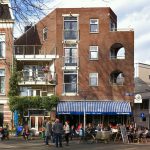 Café ’t Blaauwhooft ligt op het Bickerseiland: een kunstmatig aangelegd eiland uit de 17e eeuw. Het eiland werd vernoemd naar de rijke koopmansfamilie Bicker. Op de eilanden waren pakhuizen, kleine scheepswerven en bedrijven gelieerd aan de scheepvaart. Aan de achterkant van het eiland loopt het treinspoor, met ‘onder de bogen’ kleine bedrijfsruimtes. Het Hendrik Jonkerplein is vernoemd naar het familiebedrijf Jonker dat hier een werktuigenfabriek had. De naam ’t Blaauwhooft verwijst naar het bolwerk van de stadsmuren dat hier lag.
Café ’t Blaauwhooft ligt op het Bickerseiland: een kunstmatig aangelegd eiland uit de 17e eeuw. Het eiland werd vernoemd naar de rijke koopmansfamilie Bicker. Op de eilanden waren pakhuizen, kleine scheepswerven en bedrijven gelieerd aan de scheepvaart. Aan de achterkant van het eiland loopt het treinspoor, met ‘onder de bogen’ kleine bedrijfsruimtes. Het Hendrik Jonkerplein is vernoemd naar het familiebedrijf Jonker dat hier een werktuigenfabriek had. De naam ’t Blaauwhooft verwijst naar het bolwerk van de stadsmuren dat hier lag.
Daan & Daan – Kattenburgerplein
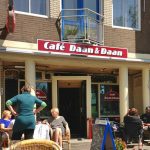 Het kunstmatige eiland Kattenburg stamt uit de tweede helft van de 17e eeuw. In het voormalige Zeemagazijn is nu het Scheepvaarmuseum gevestigd. De bewoners van Kattenburg werkten vooral in de scheepsbouw. Zij kregen als bijnaam de Bijltjes, een veelgebruikt gereedschap bij de bouw van houten schepen. Kattenburg was flink vervallen na de Tweede Wereldoorlog. In de jaren 60 werd het gerenoveerd. De gevels aan het Kattenburgerplein zijn blijven staan, daarachter zijn nieuwe woningen gebouwd.
Het kunstmatige eiland Kattenburg stamt uit de tweede helft van de 17e eeuw. In het voormalige Zeemagazijn is nu het Scheepvaarmuseum gevestigd. De bewoners van Kattenburg werkten vooral in de scheepsbouw. Zij kregen als bijnaam de Bijltjes, een veelgebruikt gereedschap bij de bouw van houten schepen. Kattenburg was flink vervallen na de Tweede Wereldoorlog. In de jaren 60 werd het gerenoveerd. De gevels aan het Kattenburgerplein zijn blijven staan, daarachter zijn nieuwe woningen gebouwd.
De Waterkant
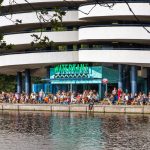 Het Surinaamse café De Waterkant bevindt zich onderin een parkeergarage. De parkeergarage van architect Piet Zandstra werd gebouwd in de jaren 60. De meningen verschillen, de een vindt het spuuglelijk, de ander juist mooie architectuur. Bijnaam voor het pand werd al snel ‘de billen van Zandstra’. De Amerikaanse kunstenaar Spencer Tunick fotografeerde in 2007 ruim 2000 blote mensen in deze parkeergarage.
Het Surinaamse café De Waterkant bevindt zich onderin een parkeergarage. De parkeergarage van architect Piet Zandstra werd gebouwd in de jaren 60. De meningen verschillen, de een vindt het spuuglelijk, de ander juist mooie architectuur. Bijnaam voor het pand werd al snel ‘de billen van Zandstra’. De Amerikaanse kunstenaar Spencer Tunick fotografeerde in 2007 ruim 2000 blote mensen in deze parkeergarage.
Kanis & Meiland
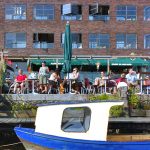 Café Kanis & Meiland bevindt zich op het KNSM-eiland. De KNSM (Koninklijke Nederlandse Stoomboot-Maatschappij vervoerde tussen 1856 en 1981 vracht en passagiers van Amsterdam naar onder andere Amerika en Indonesië. Nadat in 1977 de KNSM vertrok, werd het eiland bewoond door krakers, kunstenaars en stadsnomaden. Vanaf de jaren 90 kwam hier nieuwbouw die zeer in trek is bij moderne stadsbewoners.
Café Kanis & Meiland bevindt zich op het KNSM-eiland. De KNSM (Koninklijke Nederlandse Stoomboot-Maatschappij vervoerde tussen 1856 en 1981 vracht en passagiers van Amsterdam naar onder andere Amerika en Indonesië. Nadat in 1977 de KNSM vertrok, werd het eiland bewoond door krakers, kunstenaars en stadsnomaden. Vanaf de jaren 90 kwam hier nieuwbouw die zeer in trek is bij moderne stadsbewoners.
Tekst: Christine van Eerd
